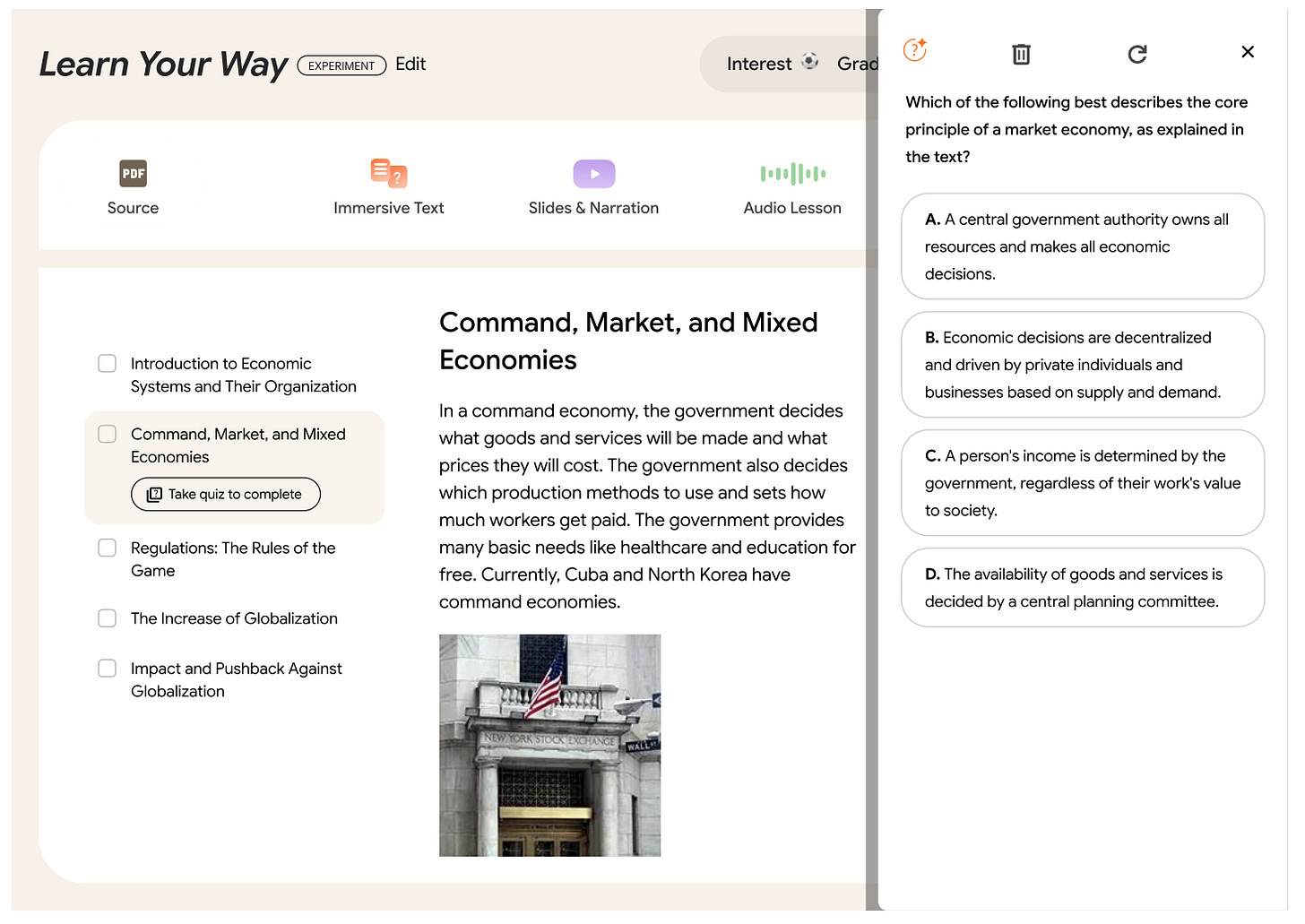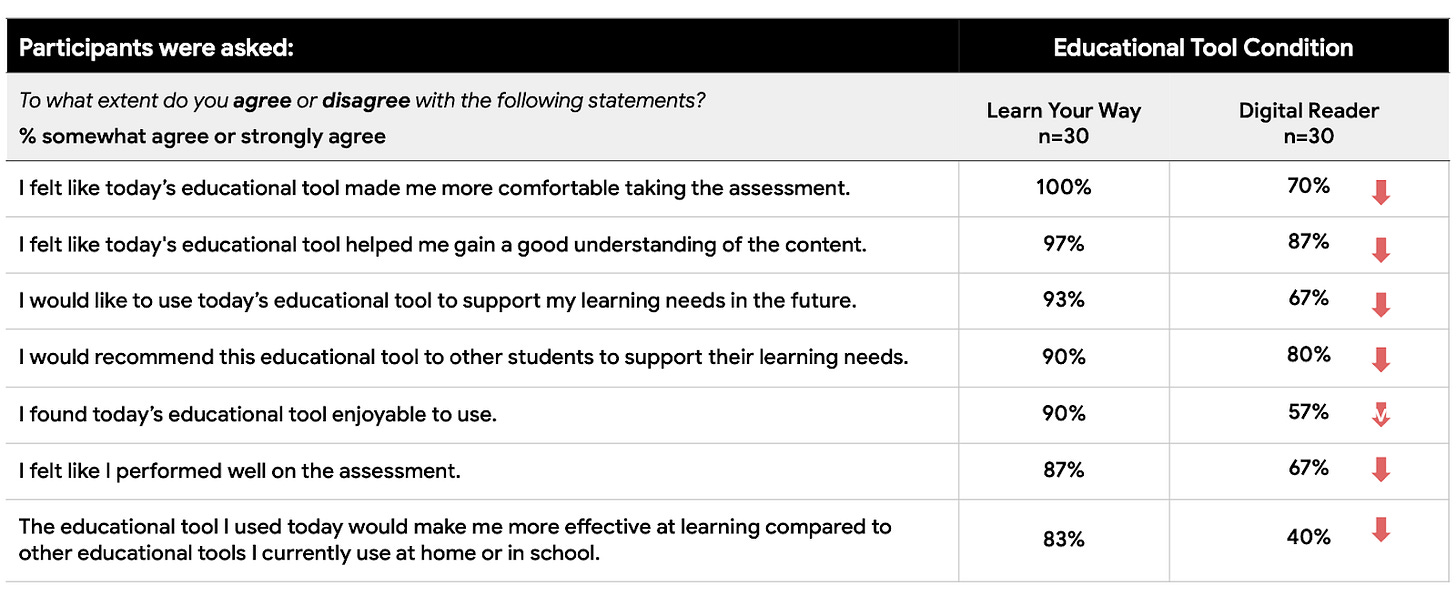Towards the AI-Augmented Textbook: How Google’s LearnLM Is Personalizing Education
Inside the next wave of education technology, where generative AI transforms static textbooks into dynamic, personalized learning companions.
Introduction
Remember the classic Math or Biology textbooks? Those heavy, static ones recommended for an entire class. It’s the same identical textbook for every single student. It didn’t matter if you were a visual learner who thrived on diagrams, or one who learns faster with audio-absorbed information from lectures, or even one who learns best with generic examples or scenarios. Every learner reads the same examples, the same explanations, at the same difficulty level. The textbook was a one-size-fits-all, and you had to fit the mold.
Now imagine a textbook that adapts to you. One that can explain trivial concepts in the language of your favorite sport, and it’s capable of adjusting its tone to your learning pace. If you love dogs, it explains evolution by showing how all the different breeds came from the same ancient ancestor. This is what AI is capable of and a research study from Google’s LearnLM team titled “Towards an AI-Augmented Textbook” is bringing this to reality.
This groundbreaking study unveils a powerful approach to significantly revolutionizing traditional education since its inception. They present a system called “Learn Your Way” which uses generative AI not to replace textbooks, but to transform them into flexible personalized companions. This technology adds layers of customization and multiple representations like interactive timelines, memory aids, and embedded quizzes. All while staying true to the original curriculum-approved content.
The idea here is simple: What if every student could learn from a textbook that feels like it was designed specifically for them? The study tells us we are on the cusp of getting that question answered. It goes beyond mere concept, providing robust evidence from a controlled trial showing that students who used the AI-augmented system not only understood the textbook material more quickly, but also retained more knowledge days later compared to those using the traditional textbooks.
AI has been making waves in the past decade across different industries, but education hasn’t changed much in centuries. If we view teaching/learning as a technology, we can all agree that it is outdated and in need of improvement.
The Problem with Traditional Textbooks
Textbooks have been around for centuries, as far back as the printing press of the 15th century. This revolution standardized learning for everyone by spreading knowledge beyond just some privileged few, which was a breakthrough for their time. But what was once a significant milestone has now become a limitation in a world that thrives on adaptability. It suffers from a fundamental and unavoidable flaw: it is a one-size-fits-all medium. It forces everyone to learn from the same static pages regardless of their unique learning style, prior knowledge or personal interests.
This rigidity creates several key challenges:
The Scalability Problem: The material cannot be adapted in a scalable manner. Consider what it would take to manually create personalized versions of a single textbook chapter. You would need to:
Rewrite the content for multiple grade levels
Develop different examples tailored to various student interests
Create alternative presentation formats (audio, visual, interactive)
Generate appropriate assessment questions for each version
Ensure all versions maintain the same factual accuracy and curriculum alignment
Now multiply that effort across every chapter, every subject, and every student. The task quickly becomes impossible. A team of educators might spend weeks creating a handful of personalized versions, but they could never produce enough to truly adapt to individual learner needs at scale.
The Labor-Intensive Update Process: Any new material or alternative representation requires human effort. Creating a single new resource, such as a set of explanatory slides, an audio summary, or a practice quiz, demands time and expertise from educators and instructional designers. This high cost of creation severely limits the variety and volume of supplemental materials that can be produced, leaving students with fewer options to aid their understanding.
The One-Size-Fits-All Content: Every learner, regardless of their unique characteristics, is presented with the same, non-adaptive content. The struggling reader, the advanced learner seeking deeper challenge, the visual learner, and the auditory processor all receive an identical, static version of the text. The textbook makes no distinction between them, failing to accommodate different reading levels, personal interests, or preferred learning modalities.
Simply put: the traditional textbook is a monologue. It’s not conversational, it doesn’t adapt, and it has no regard for who is reading it. In an age where music streams, news feeds and post pages are curated and tailored to personalized experiences, the static textbook is left behind.
The Proposed AI Solution: Learn Your Way
The team at Google LearnLM designed a system called “Learn Your Way” to curb these problems, one that uses generative AI to address the long-standing rigidity of traditional textbooks. The straightforward plan here is: instead of expecting every student to adapt to a single version of a textbook, the textbook itself should adapt to each student. It uses a two-stage generation process.
Text Personalization
In this first stage, the system rewrites the original textbook material to match specific attributes of the learner using two key attributes:
Grade Level: Firstly, the AI uses metrics like the student’s reading level, their vocabulary and comprehension level to re-write the original textbook content while maintaining all the factual content and curriculum requirements. A seventh grader can now learn a mathematical formula at the college-level without the quality being reduced by simply using language appropriate to their reading ability.
Personal Interests: Here, students select a personal interest like sports, music or art, and the system identifies portions of the text where this interest can be snuck in naturally. This is done selectively, replacing specific examples with relatable ones. For instance, Newton’s Third Law can be explained using the recoil of a basketball pass. This not only boosts engagement but also helps anchor new knowledge to the learner’s existing conceptual networks.
Multiple Representations
Once the text is personalized, Learn Your Way generates multiple ways to experience the same content. They can include:
Immersive Texts: Enhanced versions of the original text with embedded examples, questions, and visuals.
Slides and Narration: AI-generated summaries and narrated lessons that simulate classroom instruction.
Audio Lessons: Conversational explanations between a virtual teacher and student.
Mind Maps: Visual diagrams that break down concepts and show relationships between ideas.
Embedded Questions & Quizzes: Interactive questions that help learners test understanding in real time.

Putting all these transformations together, it makes the textbook dynamic, multimodal and adaptive. Learners can switch between formats depending on preferences like reading, listening or visuals then the AI adjusts accordingly. It gives an experience that feels more like a conversation than a lecture. Learn Your Way demonstrates a practical and powerful blueprint for using generative AI to create a responsive, student-centric learning medium.
Results and Implications
The team at Google proved this was not all theory and subjected it to rigorous evaluation through both expert pedagogical review and a randomized controlled trial with students. The results demonstrate a significant positive impact on learning outcomes and the overall student experience.

Teaching experts in academia evaluated Learn Your Way across 10 different textbook chapters in topics from sociology to physics across 3 grade, 7th grade, 10th grade, and undergraduate level as well as 3 personal interests. On a rating of 0-1, 1 representing full agreement with teaching standards, these experts rated the overall system 0.9. The only weaker area was visual illustrations, as current AI models still struggle to generate simple, teaching-friendly images.
60 school students from the Chicago area, aged 15-18, participated in a randomized controlled trial. Students were pre-screened for similar reading abilities, then randomly assigned to either Learn Your Way or a standard digital reader (Adobe Acrobat). Both groups studied the same textbook chapter on brain development for 20-40 minutes, then completed identical assessments. The results were not close: 2 tests were given to both groups, one immediately and another 3 days later to test their retention strength. Learn Your Way users scored significantly higher on both showcasing meaningful gains in both comprehension and long-term retention.
Aside from comprehension of the contents, the new system also enhanced their learning experience. As shown in Figure below, student surveys revealed that “Learn Your Way” was consistently rated more positively. Key findings include:
100% of “Learn Your Way” users felt the tool made them more comfortable taking the assessment, compared to 70% in the control group.
93% expressed a desire to use the tool for future learning, versus 67% for the digital reader.
83% believed it would make them more effective learners, compared to only 40% for the standard tool.

These findings have revolutionary implications that go much beyond this particular experiment. Education itself can become scaled and individualized if textbooks can be dynamically rewritten, displayed, and narrated in real time. Teachers or instructors could use AI Textbooks to:
Detail differentiated instructions without any workload overhead
Assess students’ progress adaptively
Personalize lessons based on real-time feedback from learners.
All roads in the study lean toward a future where education is not solely defined by static materials, but dynamic systems that lean alongside the learner.
Conclusion
Learn Your Way is an experimental learning experience which uses Generative AI to tailor personalized dynamic learning approaches to students rather than the static textbooks we are all used to. However, it has not been publicly released yet. The LearnLM team used Google’s latest most advanced flagship model designed for education, Gemini 2.5 Pro. It can understand context, personalize information, and present it in ways that truly support human learning.
For the first time, the vision of truly personalized learning at scale isn’t just theoretical anymore, it’s practically achievable. The new system doesn’t just regenerate content at will or randomly, it preserves the accuracy of the original textbook while sprinkling touches of personalization and presenting them in various formats like narrated slides, audio lessons, mind maps, quizzes, and even memory aids.
The novel research wasn’t all hay and sunshine, it fell short and had its challenges in some areas. The system’s visual illustration component performed below expectations due to the current difficulty of producing simple images with AI. There are also questions around data privacy and equitable access to an advanced tool like this in schools with limited resources. This is a reminder that AI integration into education must be gradual, transparent and guided by humans.
Education has always evolved from chalkboards to computers, and now, from static PDFs to intelligent personalized companions. If this study is any indication, the next generation of learning materials won’t just teach, they’ll learn alongside us.
References
Winoto, I., Shah, N. B., Togelius, J., & Hajishirzi, H. (2024). Towards an AI-Augmented Textbook. Google Research. Available: https://services.google.com/fh/files/misc/ai_augmented_textbook.pdf


Interesting read. I wonder if teachers might struggle to keep their curriculum consistent with AI creating variation.